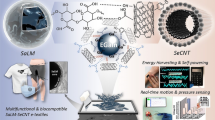Abstract
Stretchable electronics can go beyond what might commonly be considered “electronics.” They can exploit their inherent elasticity to enable new types of transducers that convert between electrical energy and mechanical energy. Dielectric elastomer actuators are “stretchable capacitors” that can offer muscle-like strain and force response to an applied voltage. As generators, dielectric elastomers offer the promise of energy harvesting with few moving parts. Power can be produced simply by stretching and contracting a relatively low-cost rubbery material. This simplicity, combined with demonstrated high energy density and high efficiency, suggests that dielectric elastomers are promising for a wide range of energy-harvesting applications. Indeed, dielectric elastomers have been demonstrated to harvest energy from human walking, ocean waves, flowing water, blowing wind, pushing buttons, and heat engines. While the technology is promising and advances are being made, there are challenges that must be addressed if dielectric elastomers are to be a successful and economically viable energy-harvesting technology. These challenges include developing materials and packaging that sustain a long lifetime over a range of environmental conditions, designing the devices that stretch the elastomer material uniformly, and system issues such as practical and efficient energy-harvesting circuits.








Similar content being viewed by others
References
Y. Bar-Cohen, Ed., Electroactive Polymer (EAP) Actuators as Artificial Muscles: Reality, Potential and Challenges, 2nd ed. (SPIE Press, Bellingham, WA, 2004).
F. Carpi, H.-E. Kiil, R. Kornbluh, P. Sommer-Larsen, G. Alici, in Proceedings of Actuators, H. Borgmann, Ed. (2010), pp. 405 – 417.
R. Pelrine, R. Kornbluh, Q. Pei, J. Joseph, Science 287 (5454), 836 (2000).
R. Kornbluh, R. Pelrine, Q. Pei, S. Oh, J. Joseph, Proc. SPIE, Smart Structures and Materials 2000: Electroactive Polymer Actuators and Devices (EAPAD) 3987, 51 (2000).
P. Brochu, Q. Pei, Macromol. Rapid Commun. 31, 10 (2010).
F. Carpi, D. DeRossi, R. Kornbluh, R. Pelrine, P. Sommer-Larsen, Dielectric Elastomers as Electromechanical Transducers. Fundamentals, Materials, Devices, Models and Applications of an Emerging Electroactive Polymer Technology (Elsevier Press, Amsterdam, The Netherlands, 2008).
R. Pelrine, R. Kornbluh, J. Eckerle, P. Jeuck, S. Oh, Q. Pei, S. Stanford, Proc. SPIE, Smart Structures and Materials 2001: Electroactive Polymer Actuators and Devices (EAPAD) 4329, 148 (2001).
S. Ashley, Scientific American 289 (4), 52 (2003).
S. Chiba, M. Waki, R. Kornbluh, R. Pelrine, Proc. of SPIE 6927, Electroactive Polymer Actuators and Devices (EAPAD) 692715 (2008).
H. Prahlad, R. Kornbluh, R. Pelrine, S. Stanford, J. Eckerle, S. Oh, Proceedings of ISSS 2005 International Conference on Smart Materials Structures and Systems, SA-100-SA-107 (Bangalore, India, 2005).
C. Graf, J. Maas, D. Schapeler, Proc. SPIE 7642, Electroactive Polymer Actuators and Devices (EAPAD) 764217 –1 (2010).
C. Graf, J. Maas, D. Schapeler, 10th IEEE International Conference on Solid Dielectrics (2010), pp. 752–756.
R. Pelrine, R. Kornbluh, J. Joseph, Sens. Actuators, A 64, 74 (1998).
F. Carpi, D. DeRossi, R. Kornbluh, R. Pelrine, P. Somer-Larsen, Dielectric Elastomers as Electromechanical Transducers. Fundamentals, Materials, Devices, Models and Applications of an Emerging Electroactive Polymer Technology (Elsevier Press, Amsterdam, The Netherlands, 2008), chap. 4.
G. Kofod, D.N. McCarthy, H. Stoyanov, M. Kollosche, S. Risse, H. Ragusch, D. Rychkov, M. Dansachmuller, R. Wache, Proc. SPIE 7642, 76420J (2010), doi:10.1117/12.847281.
S.J.A. Koh, C. Keplinger, T. Li, S. Bauer, Z. Suo, IEEE/ASME Trans. Mechatron. 16, 33 (2011).
F. Carpi, D. DeRossi, R. Kornbluh, R. Pelrine, P. Somer-Larsen, Dielectric Elastomers as Electromechanical Transducers. Fundamentals, Materials, Devices, Models and Applications of an Emerging Electroactive Polymer Technology (Elsevier Press, Amsterdam, The Netherlands, 2008), chap. 7.
M. Benslimane, H.-E. Kiil, M.J. Tryson, Proc. SPIE 7642, Electroactive Polymer Actuators and Devices (EAPAD) 2010, 764231 (2010).
R. Kornbluh, in F. Carpi, D. DeRossi, R. Kornbluh, R. Pelrine, P. Sommer- Larsen, Dielectric Elastomers as Electromechanical Transducers. Fundamentals, Materials, Devices, Models and Applications of an Emerging Electroactive Polymer Technology (Elsevier Press, Amsterdam, The Netherlands, 2008), chap. 8.
R. Pelrine, H. Prahlad, in F. Carpi, D. DeRossi, R. Kornbluh, R. Pelrine, P. Sommer-Larsen (Eds.), Dielectric Elastomers as Electromechanical Transducers. Fundamentals, Materials, Devices, Models and Applications of an Emerging Electroactive Polymer Technology (Elsevier Press, Amsterdam, The Netherlands, 2008), chap. 15.
C. Jean-Mistral, S. Basrour, J.-J. Chaillout, Smart Mater. Struct. 19, 085012 (2010).
Y. Liu, K.L. Ren, H.F. Hofmann, Q. Zhang, IEEE Trans. Ultrason. Ferroelectr. Freq. Control 52 (12), 2411 (2005).
R. Kornbluh, R. Pelrine, H. Prahlad, A. Wong-Foy, B. McCoy, S. Kim, J. Eckerle, T. Low, Proc. SPIE, 797605 (2011), doi:10.1117/12.882367.
J.A. Paradiso, T. Starner, IEEE Pervasive Computing 4 (1), 18 (2005).
Electric Power Research Institute, Ocean Tidal and Wave Energy, Renewable Energy Technical Assessment Guide (TAG-RE 1010489, 2005).
U.S. Department of Energy. Mapping and Assessment of the United States Ocean Wave Energy Resource (EPRI, Palo Alto, California), 2011.
R. Kornbluh, A. Wong-Foy, R. Pelrine, H. Prahlad, B. McCoy, MRS Proceedings: 1271-JJ03-01 (2010), doi: 10.1557/PROC-1271-JJ03-01.
Acknowledgments
The authors wish to thank their colleagues at SRI International, whose efforts contributed to the work presented here. We would also like to thank the numerous clients and government funding agencies whose support over the past 20 years has enabled much of this work. In particular, Shuiji Yonemura and Mikio Waki of HYPER DRIVE Corp. have generously supported our development of the ocean wave power harvesting systems.
Author information
Authors and Affiliations
Corresponding author
Rights and permissions
About this article
Cite this article
Kornbluh, R.D., Pelrine, R., Prahlad, H. et al. Dielectric elastomers: Stretching the capabilities of energy harvesting. MRS Bulletin 37, 246–253 (2012). https://doi.org/10.1557/mrs.2012.41
Published:
Issue Date:
DOI: https://doi.org/10.1557/mrs.2012.41




